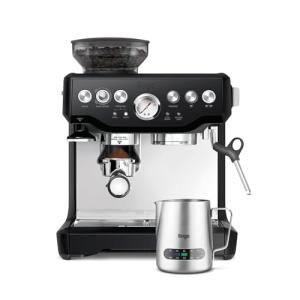The 10 Most Scariest Things About Bean-To-Cup Espresso Machine
페이지 정보

본문

The Ultimate Guide to Bean-To-Cup Espresso Machines
In a period where coffee culture has actually reached brand-new heights, the need for extraordinary home-brewed espresso is at an all-time high. Amongst the plethora of coffee-making gadgets readily available, bean-to-cup espresso machines are ending up being significantly popular. These machines assure the wonderful experience of newly ground coffee beans transformed into an abundant espresso, all from the comfort of home. In this thorough guide, we will explore the complexities of bean-to-cup espresso machines, exploring their advantages, essential functions, and offering a purchasing guide to assist you make an informed choice.
What is a Bean-To-Cup Espresso Machine?
A bean-to-cup espresso machine automates the entire coffee-making process. It grinds the coffee beans, brews the espresso, and frequently froths the milk, all at the touch of a button. This smooth experience enables coffee lovers to enjoy café-quality drinks from the comfort of their homes.
Why Choose a Bean-To-Cup Espresso Machine?
| Pros | Cons |
|---|---|
| Freshly ground coffee | Usually more expensive |
| Automated process | Can use up counter space |
| Customizable settings | Requires regular cleansing |
| Vast array of coffee types | Minimal to machine abilities |
| Typically includes milk frothing |
Benefits of Bean-To-Cup Espresso Machines
- Freshness: The grinding process happens prior to brewing, which indicates that the coffee maintains its freshness and aromatic qualities.
- Convenience: With simply the push of a button, coffee lovers can enjoy their favorite espresso without the need for a separate grinder or steam wand.
- Modification: Many models allow users to change different specifications, such as the grind size, water temperature, and milk frothing consistency.
- Space-Saving: By combining numerous gadgets, bean-to-cup machines minimize mess on the counter top.
Secret Features to Look For
When searching for a bean-to-cup espresso machine, it's important to think about a few vital functions:
| Feature | Value |
|---|---|
| Grind Settings | Identifies the consistency of the ground coffee. A wider range permits for more customization. |
| Developing Pressure | A higher pressure typically leads to a better extraction and richer Espresso Maker. Suitable pressure is around 9 bars. |
| Milk Frother | Vital for cappuccinos and lattes. Choose between manual and automatic frothing options. |
| Easy Cleaning Mechanism | Try to find machines with removable elements and automatic cleansing cycles for convenience. |
| Water Tank Capacity | Larger tanks reduce the frequency of refilling, ideal for regular usage. |
| User Interface | A digital screen or app connection can boost user experience. |
Popular Bean-To-Cup Espresso Machines
Here are some popular models on the marketplace today, highlighting their unique functions:
| Model | Grinder Type | Milk Frother | Pressure | Rate Range |
|---|---|---|---|---|
| De'Longhi Dinamica | Cone-shaped | Automatic | 15 bars | ₤ 800 - ₤ 1,000 |
| Jura E8 | Ceramic | Automatic | 15 bars | ₤ 2,000 - ₤ 2,500 |
| Breville Oracle | Dual Boiler | Manual | 9 bars | ₤ 1,500 - ₤ 2,000 |
| Saeco Xelsis | Flat Burr | Automatic | 15 bars | ₤ 1,800 - ₤ 2,200 |
| Philips 3200 Series | Round | Manual | 15 bars | ₤ 600 - ₤ 800 |
How to Brew the Perfect Espresso
Using a bean-to-cup espresso machine may appear uncomplicated, however achieving the ideal espresso requires attention to detail. Follow these steps for a delicious cup:
- Select Quality Beans: Start with fresh, top quality coffee beans to make sure the very best flavor.
- Adjust Grind Size: Depending on the type of coffee bean and your taste choice, explore the grind size for ideal extraction.
- Water Temperature: Water regularly around 195 ° F to 205 ° F is ideal for Espresso Machine With Milk Frother brewing.
- Tamp the Coffee: If your machine enables, tamp the coffee equally to guarantee uniform extraction.
- Display Brew Time: Aim for an extraction time of 25 to 30 seconds for the right balance of tastes and crema.
Regularly Asked Questions (FAQs)
1. What is the distinction in between a bean-to-cup machine and a conventional espresso machine?
A bean-to-cup machine automates the grinding and brewing procedures, while conventional Portable Espresso Maker machines often need manual intervention for grinding and tamping.
2. Are bean-to-cup machines simple to clean up?
Most modern machines are developed with ease of cleansing in mind, including detachable parts and automatic cleansing cycles. However, regular upkeep is crucial for optimal efficiency.
3. Can I use pre-ground coffee in a bean-to-cup machine?
A lot of bean-to-cup machines are developed particularly for whole beans. Nevertheless, some designs might have a bypass doser for utilizing pre-ground coffee.
4. What kind of maintenance do bean-to-cup machines require?
Regular upkeep consists of cleaning up the coffee grounds container, water tank, and milk frother, as well as descaling the machine every few months, depending upon the water hardness in your area.
5. How long do bean-to-cup espresso machines last?
With proper care and upkeep, premium bean-to-cup machines can last anywhere from 5 to 15 years.
A bean-to-cup Espresso Maker machine is a financial investment that can raise your home coffee experience. Integrating convenience and quality, these machines permit coffee enthusiasts to craft scrumptious espressos without the need for multiple gadgets. By comprehending the key functions and following best practices, individuals can choose the right design customized to their requirements and preferences. Whether you're a seasoned barista or a casual sipper, exploring the world of bean-to-cup Professional Espresso Machine machines is sure to brew up a wonderful experience.
- 이전글You'll Be Unable To Guess Mental Health Services Private's Benefits 25.11.13
- 다음글Why Replacement Bifold Door Seals Is Fast Becoming The Most Popular Trend In 2024 25.11.13
댓글목록
등록된 댓글이 없습니다.
